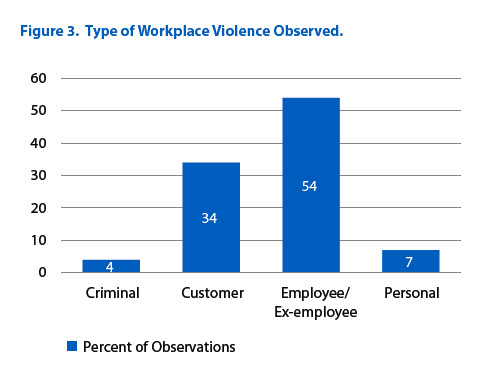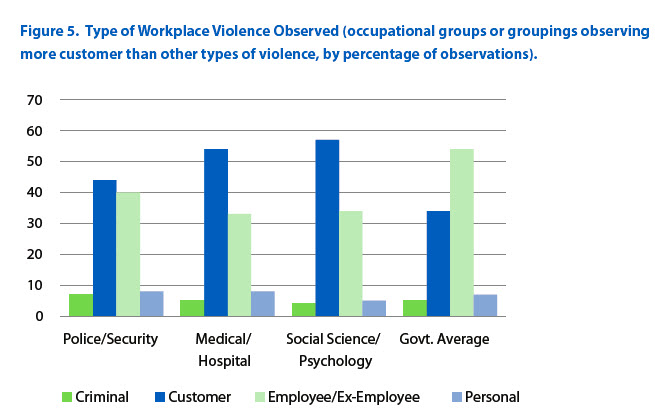Violence In The Federal Workplace Report - Sept., 2012
In September, 2012, the U.S. Merit Systems Protection Board submitted a report to Congress and President Obama entitled, Employee Perceptions of Federal Workplace Violence.
We're making this available directly to you to download, but we'll provide some of the key findings below.
Caveats and Issues
There's no real way to know how accurately survey data reflects actual behavior in the workplace, but on his issue, there's no particular reason to doubt any of the reported numbers. Generally, though, workplace violence, particularly that which does not result in physical injury, is vastly UNREPORTED, so most estimates severely under-report occurrences. In talking to thousands of government employees, and doing straw polls in my seminars, the actual incidence of verbal violence is incredibly high. Certainly over HALF of participants I've questioned have directly experienced verbal threats, abusive language, and unwanted physical contact FROM government customers.
Second, the report deals solely with violence directed at Federal employees in the USA. The numbers may not reflect violence in other countries like Canada, where there is a slightly different culture. However, as mentioned above, my experiences, primarily working with Canadians in government is that the issues, if not the extent of injuries is equally important.
As an important aside, from other research, it appears that of the three major levels of government -- Federal, State/Provincial and Municipal, that the smaller the government unit, the more likely employees will experience violence as part of their jobs. The differences seem to be quite significant.
Key Results For Violence Towards Federal Employees
Incidence of physical injury or property damage.
Of the violent incidents observed by respondents to the MPS 2010, 15 percent resulted in physical injury, 10 percent resulted in property loss or damage, and 75 percent resulted in neither of these outcomes.
Comment: That's somewhat good news, but it's also a reflection of how violence is defined by the survey and participants. What it does suggest is that it's likely that of the 75% that resulted in no physical damage were also not reported, perhaps even to immediate supervisors. Verbal abuse, and even generic verbal threats are usually NOT reported to anyone, since they are so commonplace.
Workplace VIolence Defined:
"Given this wide range of behaviors, workplace violence may be best considered an umbrella term for a broad range of conduct. This umbrella captures incidents of overt violence that may prove to be fatal or non-fatal. Threats of violence that may be direct, indirect, or conditional, or any other conduct that generates a reasonable concern for an employee’s safety while on the job, also fit under this umbrella. Such incidents may occur at the formal workplace or off-site while the employee is on duty."
Violence Includes Threats, Harrassment, Intimidation
"Although this decline in physical workplace violence is good news, leaders of Federal organizations should not become complacent in their efforts to prevent and plan for an appropriate response to incidents of workplace violence. As will be seen later in this report, the vast majority of violence observed by Federal employees did not result in physical injury—it involved threats of assault, harassment, intimidation, and bullying."
Incidents - Private vs. Public Sector
"In 2005, BLS conducted a survey of private industry and State and local government establishments in conjunction with the National Institute for Occupational Safety and Health, Centers for Disease Control and Prevention. In this survey, BLS not only asked about physical assaults, but also threats of assault, harassment, intimidation, or bullying. At that time, BLS found that half of the largest establishments (employing 1,000 or more workers) had at least one violent incident in the previous 12 months. Whereas about 5 percent of all private industry establishments reported a violent incident, 32 percent of State government establishments and 15 percent of local government establishments reported a violent incident. BLS noted that the higher reported incidence of violence in these government workplaces could be attributed to their work environments. Specifically, “[t]hese workplaces reported much higher percentages of working directly with the public, having a mobile workplace, working with unstable or violent persons, working in high crime areas, guarding valuable goods or property, and working in community based settings than did private industry.”
Consequences of Workplace Violence
"Workplace violence produces a number of consequences for individual victims as well as for organizations. Some of these consequences are easier to quantify than others. Costs to employers include restoring property, providing psychological care to victims and other affected employees, improving security, and attempting to repair an organization’s tarnished public image. Also, research suggests that the stress and strain caused by workplace violence and aggression are strongly related to high employee turnover, reduced productivity, and lower employee commitment.
However, the true cost of workplace violence could be even higher than most estimates because there may be many incidents that are not reported. Behaviors such as threats, harassment, and intimidation are rarely reported, yet they also pose risks to American workers and costs to employers.31 Often, these incidents are perpetrated by employees, and, if left unchecked, these types of behaviors can escalate into more serious and violent behaviors. Although violent assaults and homicides do occur in the workplace, it is these other behaviors that managers and supervisors regularly encounter."
Types of Workplace Violence
 Figure 3 illustrates that 88 percent of our survey respondents who observed a violent act in the previous two years reported that that act was committed by individuals who, for the most part, actually had access to or had a legitimate reason to be at the workplace— namely, customers, employees, and ex-employees. While security measures designed to keep out individuals who seek to do harm in Federal workplaces remain vitally important, these findings should draw attention to the internal threats that Federal agencies face.
Figure 3 illustrates that 88 percent of our survey respondents who observed a violent act in the previous two years reported that that act was committed by individuals who, for the most part, actually had access to or had a legitimate reason to be at the workplace— namely, customers, employees, and ex-employees. While security measures designed to keep out individuals who seek to do harm in Federal workplaces remain vitally important, these findings should draw attention to the internal threats that Federal agencies face.
A Closer Look At Government Violence, Sources, Occupations
Lumping all the numbers together across government occupations and sources of violence tends to obscure details, since there's a lot of variation that depends on type of job. Below is a graph that shows an interesting picture: That first law enforcement and health professionals are most "at risk", and that the sources/type of violence varies across occupations.

Conclusion
If you work in government, or manage or are an HR professional operating in government, we suggest you download the full report, since it's recent, and informative. One thing you will find, as illustrated in the above graph is that there are some high risk professions where the majority of violence towards government employees comes from CUSTOMERS. Which returns us to the importance of preparing staff to de-escalate customer interactions.
